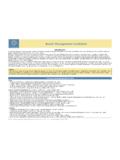Transcription of CORE FACTSHEETS Bile acid ... - gutscharity.org.uk
1 CORE FACTSHEETS Bile acid malabsorption Registered charity 1137029 If you have found this information useful please consider supporting Core Donate at or call 020 7486 0341 Written by Samantha Morgan and Mark Samaan. Published in 2016. Next review in 2018. Full range at References for this factsheet are available from Core. Please acknowledge source when quoting from this factsheet. This factsheet is about bile acid malabsorption Bile contains bile acids which are needed for breaking down and absorbing fats vitamins in the gut, and also to remove many waste products. Bile acids are made in the liver, stored in the gallbladder and released into the small intestine (gut) after a meal. About 97% of bile acids are then reabsorbed in the last portion of the small intestine (ileum) and returned to the liver.
2 This cycle repeats itself and is called the enterohepatic circulation. When this cycle is disturbed, bile acid malabsorption (abnormal absorption in the small intestine) occurs. It affects up to 1 in 100 people in the UK. Bile acid malabsorption is sometimes called bile salt malabsorption and these two terms mean exactly the same thing. Causes of bile acid malabsorption There are three different ways in which bile acid malabsorption which can occur and these can be categorised by the following three types: Type I This is when part of the small intestine (ileum), where bile acids are absorbed, has been affected. Causes include removal or inflammation of the ileum. Reasons for removal of the ileum include surgery due to conditions such as Crohn s disease (a condition which affects the whole digestive tract and causes inflammation) or cancer treatment.
3 Type II This is when no definitive cause is found and is known as primary bile acid malabsorption. Type III This can result from other diseases or conditions within the abdomen such as gallbladder removal, coeliac disease, chronic pancreatitis, radiotherapy or small bowel bacteria overgrowth. What are the usual symptoms? The main symptom of bile acid malabsorption is diarrhoea. When bile acids are not absorbed from the ileum, they are passed into the large intestine. Here, the excess bile acids irritate the lining of the large intestine and stimulate salt and water secretion, causing diarrhoea. The diarrhoea may be pale, greasy and hard to flush away. People can have up to ten episodes of diarrhoea during the day, and sometimes at night. Other symptoms include bloating, cramping abdominal pain and excessive wind.
4 Unfortunately, many symptoms of bile acid malabsorption mimic those of irritable bowel syndrome (IBS) and some IBS patients may actually have bile acid malabsorption. How is bile acid malabsorption diagnosed? The main investigation for a definitive diagnosis of bile acid malabsorption is a nuclear medicine test called the SeHCAT test. A small capsule containing an artificial bile acid called SeHCAT (75Se-homocholic acid taurine) is swallowed. A scan is done on the same day to establish the starting amount in the body, and another scan one week later to see how much has been retained. The overall result can establish how much bile acid is lost from the body. The amount of radiation in the test is very small What can be the impact of bile acid malabsorption? Bile acid malabsorption can impact a person in several ways.
5 These include the complications of the condition and medications and its overall impact on general wellbeing due to the diarrhoea. Sometimes, patients may open their bowels over ten times a day. This can affect their daily routines, and can cause psychological stress due to fear of leaving the house or travelling as they may need to be near a toilet constantly. If too much bile acid is lost from the body due to diarrhoea, there is an increased risk of the formation of gallstones and kidney stones. What treatment is available for bile acid malabsorption? Treatment mainly includes medication and dietary changes. If there is an underlying condition, such as patients with type III bile acid malabsorption, then treatment of the underlying condition can lead to improvement of symptoms. CORE FACTSHEETS Bile acid malabsorption Registered charity 1137029 If you have found this information useful please consider supporting Core Donate at or call 020 7486 0341 Written by Samantha Morgan and Mark Samaan.
6 Published in 2016. Next review in 2018. Full range at References for this factsheet are available from Core. Please acknowledge source when quoting from this factsheet. All content provided for information only. The information found is not a substitute for professional medical care by a qualified doctor or other health care professional. ALWAYS check with your doctor if you have any concerns about your condition or treatment. The publishers are not responsible or liable, directly or indirectly, for ANY form of damages whatsoever resulting from the use (or misuse) of information in this factsheet. Please contact us if you believe any information in this factsheet is in error. The medications work by binding to the bile acid in the small intestine and preventing them from irritating the large intestine.
7 These are called bile acid sequestrants and can help symptoms and improve the quality of life of sufferers. The main medications include: Colestyramine and colestipol these medications only come in powder form. Unfortunately, they do not taste nice and are not tolerated by some patients. If the dose is too high, it can cause constipation, so it is important to adjust the dose according to symptoms. Colesevelam this is a newer medication and comes in a tablet form. Some patients find it more palatable than colestyramine. These medications can affect the absorption of other drugs so must be taken 4 hours before or after other medications. Once a diagnosis of bile acid malabsorption is made, a dietician should be seen. A key piece of dietary advice will be to keep to a strictly low fat diet (40g of fat per day).
8 There are other specialised diets that can be recommended and the dietician will go through these in detail. Does bile acid malabsorption need to be monitored and, if so, how? Once bile acid malabsorption has been diagnosed, medications are likely to be started and side effects need to be monitored. However, these have some unwanted effects. These include lowering the levels of fat soluble vitamins (A, D, E and K) because the medications can disrupt the way these vitamins get into the body. Also, the medications are used to help lower cholesterol in some people. Unfortunately, the down side of this is that they can lead to an increase in different sorts of cholesterol in the blood, namely triglycerides. Therefore, regular blood tests to monitor the levels of triglycerides and vitamins are necessary. Weight loss can occur if diarrhoea is severe and it is important to monitor this.
9 It is also important to keep a note of stool frequency and consistency on a chart, as this can be used to inform the doctor as to how symptoms are controlled, and doses of medication can be adjusted if needed. How does bile acid malabsorption behave over time? This depends on the underlying cause of bile acid malabsorption. In patients with Type I bile acid malabsorption, it depends whether the ileum has been removed or not, and response to medication can be variable. Some patients with Type II bile acid malabsorption can naturally improve and no longer require medications. However, many patients may need to remain on medications for long term. What to ask your doctor when you see them? May I be referred to a dietician to see if there are any changes to my diet that may help with my symptoms? How often do I need blood tests?
10 How do I adjust my medications according to my symptoms? What more research needs to be done on bile acid malabsorption? Further research into medications to help treat bile acid malabsorption is needed. There is the potential for new hormone-based treatments in the future. For more information about research in this area please contact Core.






